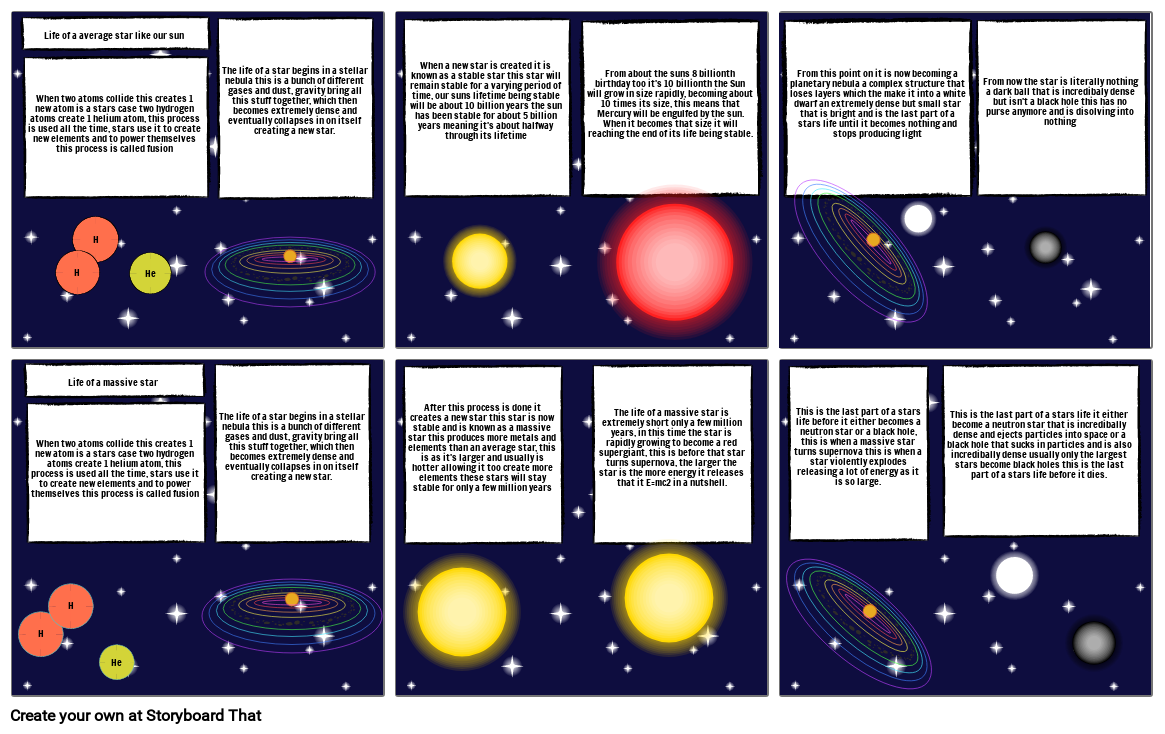Life of a Star

Storyboard Tekst
- Life of a average star like our sun
- When two atoms collide this creates 1 new atom is a stars case two hydrogen atoms create 1 helium atom, this process is used all the time, stars use it to create new elements and to power themselves this process is called fusion
- H
- H
- He
- The life of a star begins in a stellar nebula this is a bunch of different gases and dust, gravity bring all this stuff together, which then becomes extremely dense and eventually collapses in on itself creating a new star.
- When a new star is created it is known as a stable star this star will remain stable for a varying period of time, our suns lifetime being stable will be about 10 billion years the sun has been stable for about 5 billion years meaning it's about halfway through its lifetime
- From about the suns 8 billionth birthday too it's 10 billionth the Sun will grow in size rapidly, becoming about 10 times its size, this means that Mercury will be engulfed by the sun. When it becomes that size it will reaching the end of its life being stable.
- From this point on it is now becoming a planetary nebula a complex structure that loses layers which the make it into a white dwarf an extremely dense but small star that is bright and is the last part of a stars life until it becomes nothing and stops producing light
- From now the star is literally nothing a dark ball that is incredibaly dense but isn't a black hole this has no purse anymore and is disolving into nothing
- H
- Life of a massive star
- When two atoms collide this creates 1 new atom is a stars case two hydrogen atoms create 1 helium atom, this process is used all the time, stars use it to create new elements and to power themselves this process is called fusion
- H
- He
- The life of a star begins in a stellar nebula this is a bunch of different gases and dust, gravity bring all this stuff together, which then becomes extremely dense and eventually collapses in on itself creating a new star.
- After this process is done it creates a new star this star is now stable and is known as a massive star this produces more metals and elements than an average star, this is as it's larger and usually is hotter allowing it too create more elements these stars will stay stable for only a few million years
- The life of a massive star is extremely short only a few million years, in this time the star is rapidly growing to become a red supergiant, this is before that star turns supernova, the larger the star is the more energy it releases that it E=mc2 in a nutshell.
- This is the last part of a stars life before it either becomes a neutron star or a black hole, this is when a massive star turns supernova this is when a star violently explodes releasing a lot of energy as it is so large.
- This is the last part of a stars life it either become a neutron star that is incredibally dense and ejects particles into space or a black hole that sucks in particles and is also incredibally dense usually only the largest stars become black holes this is the last part of a stars life before it dies.
Meer dan 30 miljoen storyboards gemaakt

